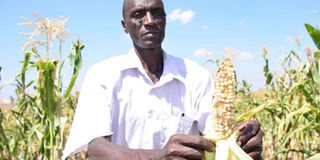Scientists’ road map in fight against deadly fall armyworm

Christopher Muasya, a maize farmer, displays a maize cob ravaged by fall armyworm in his farm in Kangundo. With the invasion of fall armyworm, a marked increase in the use of pesticides by maize growers and promotion of the same by governments through subsidies has been observed. FILE PHOTO | NMG
What you need to know:
- At a recent conference in Nairobi organised by the International Centre of Insect Physiology and Ecology (Icipe), the scientists proposed seven best practices that could help maize farmers curb the pest.
- The scientists called for adoption of safe and environmentally friendly options such as use of botanical pesticides and biopesticides to help protect the environment.
- Continuous education of farmers and extension officers is an important step to ensure the farmers use sustainable methods of fall armyworm control, which reduce and stabilise pest population to a point where it no longer poses a threat to food production.
- Scientists, however, noted the use of chemicals does not seem to work as would be expected.
Scientists have come up with a road map to help fight the stubborn fall armyworm (FAW).
At a recent conference in Nairobi organised by the International Centre of Insect Physiology and Ecology (Icipe), the scientists proposed seven best practices that could help maize farmers curb the pest. These are:
a) Use of diversified maize cropping systems
This includes maize-legume intercropping, which research has shown reduces FAW incidence from 30 to 75 per cent as compared to monocrop.
They noted promotion of diversified maize cropping system has the potential to decrease the need for pesticide application and also conserves natural enemies that can further reduce FAW population.
b) Adoption of safe control methods
The scientists called for adoption of safe and environmentally friendly options such as use of botanical pesticides and biopesticides to help protect the environment.
c) Strengthen research
Sharing of research findings was identified as one of the most important steps in understanding the in-depth biology and ecology of the pest especially in the African context where the climatic conditions are different from North American countries where it originated.
d) Awareness creation
Continuous education of farmers and extension officers is an important step to ensure the farmers use sustainable methods of fall armyworm control, which reduce and stabilise pest population to a point where it no longer poses a threat to food production.
e) Pest develops resistance to chemicals
With the invasion of fall armyworm, a marked increase in the use of pesticides by maize growers and promotion of the same by governments through subsidies has been observed.
Scientists, however, noted the use of chemicals does not seem to work as would be expected. Although some chemicals show some degree of efficacy against the fall armyworm, the pest is developing resistance to some chemicals.
f) Danger of chemicals
Some chemical combinations showed some level of efficacy but poisonous residue remained on maize and in soils sprayed, making it poisonous for people and animals.
Chemicals are known to kill non-target organisms like bees and natural enemies of FAW that could disrupt establishment of prey-predator balance that is very essential in the natural control of FAW.
g) Natural methods more effective
Scientists advocated “push-pull technology”, maize-legume intercropping systems and use of botanical and microbial pesticides.
Field surveys have also indicated the presence of effective parasitoids of FAW already in Africa.




